With the Equity Quote Cube Level I and II and time-of-sales data for equities and futures can be viewed. You can also:
Display
book depth across multiple color-coded exchanges
Issue
and cancel orders directly
Selectively
hide/show quotes for a particular exchange
Immediately
display Bid/Ask, Volume, Low/High, and VWAP
View
quotes consolidated by price or average liquidity
View
real-time and historical ticks across multiple exchanges
View
orders interleaved with book depth data
Configure
grid colors and fonts
Place and cancel orders directly from the grid or from an attached order ticket
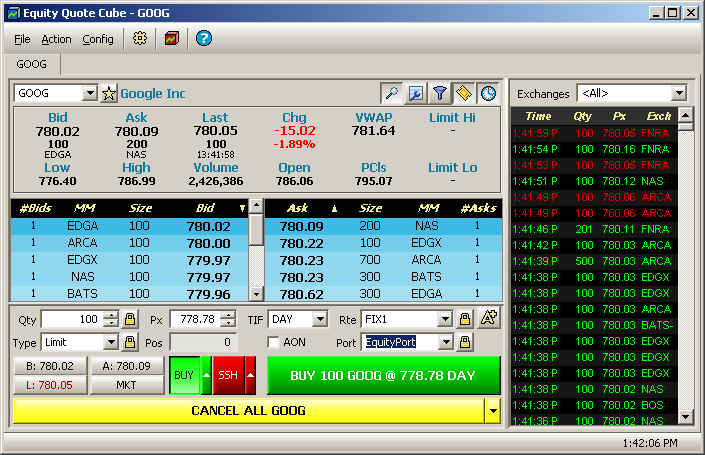
From the WTP toolbar select Analyze-->Equity Quote Cube.
Alternate Method:
From the WTP menu, select Equity Quote Cube.
The Equity Quote Cube is divided into quadrants, each of which can customized:
Security
Detail (left, top, can be turned on or off)
Book
Data Grids (center, can be configured)
Order
Ticket (left, bottom, can be turned on or off)
Ticker (right, can be turned on or off and configured)
The Equity Quote Cube can track and display a security from other WTP applets. For example, if Toggle Symbol Tracking is enabled and a symbol is placed in the Order Ticket, the Equity Quote Cube will now display information about the symbol.
Enable/Disable Toggle Symbol Tracking:
Press the Toggle Symbol
Tracking button ![]() .
.
Alternate
Method:
Right-click on the Equity Quote Cube and select Toggle Symbol Tracking
Re-selecting Toggle Symbol Tracking disables the feature.
Learn more about Toggle Symbol Tracking here.
The Quote Detail portion of the Equity Quote Cube displays:
Bid/Ask/Last
prices along with the most recent trade, the exchange, and time
of execution
Change
(price and percentage)
VWAP
(Volume-Weighted Average Price)
Low/High
prices (for the current trading day)
Trade
volume (number of shares)
Open
price (start-of-the-day price)
PCls (price at closing)
To view quote details in the Equity Quote Cube:
Press the Show/Hide
Security Detail button  to show the quote details
to show the quote details
Alternate Methods:
Right-click
anywhere in the Equity Quote Cube and select Show Security
Detail.
From the Config menu select Show Security Detail.
Either method toggles the display to show or hide the security details.
Bid and Ask Orders from the Quote Detail
Enter an order by clicking on Bid or Ask. The Order Ticket will display with the Bid/Ask value filled in.
Columns, rows, and other data displayed in the Equity Quote Cube can be configured.
The Configuration Window
To launch the configuration window:
Select the configuration
button ![]() .
.
Alternate Methods:
Right-click
in the Equity Quote Cube and select Configuration.
From the Config menu select Configuration.
The Configure Equity Quote Cube Tab
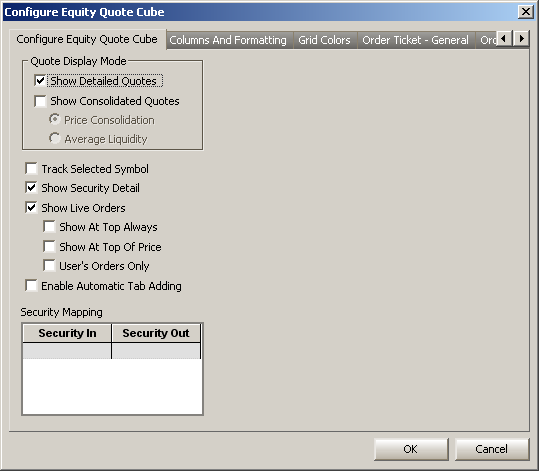
Select Show Detailed Quotes to view detailed data about a security (including, but not limited to, number of bids, market maker identity, ask/bid values, number of bids/asks).
Select Show Consolidated Quotes to view quotes that are:
Price
Consolidation—All matching prices are grouped together in
one entry where the #Bids or #Asks columns list the quantity of
Bids or Asks.
OR
Average Liquidity—The available quantity at a given price.
Either Show Detailed Quotes or Show Consolidated Quotes must be selected. Both may be selected, but the Show Consolidated Quotes option may only have one type of consolidated quote.
Alternate
Method:
You can also choose the quote mode by selecting the Select Grid
Mode button  and making your choice from
the list of quote modes.
and making your choice from
the list of quote modes.
Track Selected Symbol
Checking the Track Selected Symbol box causes the symbol in the Equity Quote Cube to be tracked in other WTP applets. See Toggle Symbol Tracking for more information.
Show Security Detail
When this box is checked, the security detail will appear in the upper left portion of the Equity Quote Cube.
Note:
The Show Security Detail option can also be accessed from the Workspace
toolbar in pinned mode (Equity Quote Cube-->Config-->Show Security
Detail) or by clicking the Show/Hide Security Detail button
 , or by right-clicking in the Equity Quote Cube
window and selecting Show Security Detail.
, or by right-clicking in the Equity Quote Cube
window and selecting Show Security Detail.
Show Live Orders
Selecting this option will display your live orders initiated from the Equity Quote Cube and orders sent to the Equity Quote Cube from other WTP applets (for example Order Ticket or Basket Trader via the send to--> command).
If Show Live Orders is checked you may also choose the manner in which live orders are displayed:
Show
Live Orders at the Top Always places live orders at the top of
the book data grid, regardless of their bid price.
Show
At Top Of Price will display the live order at the very top of
a price grouping.
User's Orders Only will hide all orders not generated by the current user.
Enable Automatic Tab Adding
Equity Quote Cube can add new tabs as they're being typed. Learn more about this feature here.
Security Mapping
With Security Mappings, one or more securities are defined and placed in the Security In column. For each security, a Security Out is defined. When sending a Security In security from a WTP applet, the Equity Quote Cube will respond by displaying the Security Out security.
In the image above, security AA is mapped to security DELL. If toggle symbol tracking is enabled, the Equity Quote Cube will display the DELL security whenever the Option Quote Cube selects the AA security.
Note 1: When mapping, a Security Out security may be used multiple times but a Security In security may be used only once.
Note 2: If toggle symbol tracking is disabled, the Equity Quote Cube will also respond to the mapping if the Security In symbol is sent to it via an applet's send to--> command.
Note 3: WTP's Connections feature works with similar functionality.
Columns and Formatting

The displayed columns and their attributes are configured on this screen.
Mirrored Layout
Mirrored Layout refers to displaying the same columns in both the ASK and BID grids (i.e., one grid mirrors the other so that the first column in the BID grid will be reflected as the last column in the ASK).
For example, a column is added/deleted to/from the BID grid. Go into Configure Equity Quote Cube, check Mirrored Layout and save. The same column is automatically added/deleted to/from the ASK grid.
If a new column is added to the either grid and the new column is not reflected in the other grid it is because Mirrored Layout is unchecked.
Available Columns
See
Field
Chooser for information on how to search for, and add, columns
to grids.
Grid Defaults, Row Color Conditions, Column Header Style
Information on setting grid defaults, row color conditions, and column headers can be found here.
Tabs in Equity Quote Cube
Tabs can be customized and arranged in alphabetical order.
Learn more about tabs here.
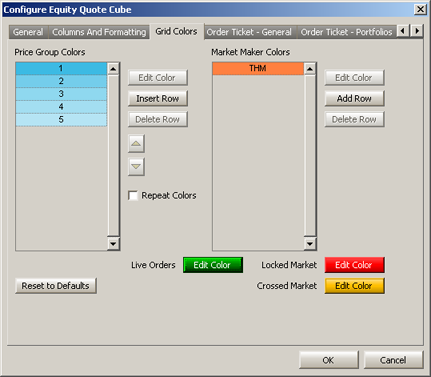
A color scheme can be defined to group quotes by price or market maker. Additional colors can be configured to identify local orders as well as markets that are either locked or crossed.
Set Price Group Colors
A price group is a collection of quotes that have the same price.
Edit a group color
Double click
on a row or click once on a row and press the Edit Color
button.
Select a color (or define a custom color) and click OK.
Insert a Row
Click on
any existing color in the Price Group.
Press Insert
Row. A new row will be placed above the row that was
selected.
Delete
a Row
When a row is deleted, the color is deleted with it. For example:
Price Group Color #1 is green and Price Group Color #2 is yellow. If Price Group Color #1 is deleted, Price Group Color #2 will move into the first position but will remain yellow.
To delete a row:
Click on
a row to be deleted.
Pres Delete Row.
Set Market Maker Colors
Configuring a Market Maker color will result in any quote from that Market Maker being displayed in the chosen color. A separate color can be assigned to each Market Maker.
To define Market Maker Colors:
Click Add
Row. A Market Maker ID window will display.
Enter the
Market Maker ID in the empty field. Click OK.
Select a
color swatch or define a custom color. Click OK.
Repeat to define the colors for other Market Makers.
Editing colors, adding and deleting rows, are handled in the same manner as the Price Group Colors.
Moving an Existing Color to a Different Price Group
An existing Price Group color can be moved to a different Price Group. For example:
Price Group Color #2 is yellow, but it is desired to have Price Group #6 in yellow. Using the down arrow, the yellow color is moved into Price Group #6. Price Group #2 will take the color that was previously defined in Price Group #3.
To assign an existing color to a different price group:
Click on
a row that will have its color assigned to a different price group.
Click on
the UP or DOWN arrows until the color is placed
in the desired Price Group.
Result: The desired Price Group will take on the new color while
the row selected in Step #1 will take the color from the next
adjacent row.
Repeat Colors
If there are more Price Groups or Market Makers than there are configured colors, the colors will be repeated.
For example, if 5 Price Groups are defined, but there are 7 displayed in the Equity Quote Cube, the grid will color Price Group 6 the color of Price Group 1. Price Group 7 will be colored the same as Price Group 2, etc.
Set Colors for Live Orders, Locked Markets, and Crossed Markets
Press the Edit Color button on each to define its respective color.
Note: Locked and Crossed Market colors have precedence over the Price Group or Market Maker colors.
Default Colors
Press Reset to Defaults to reset all colors to their original default values.
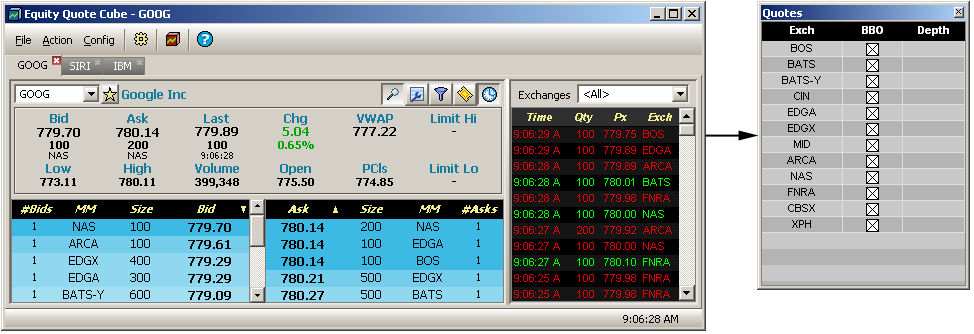
New dynamic Quotes window displays the exchanges on which a selected symbol trades.
Equity Quote Cube provides the names of all exchanges on which a selected symbol trades.*
To view the exchanges on which a selected symbol trades:
Select the Select Quote/Book Sources button
 .
.
Alternate
Methods:
From the Config menu, select Filter
Quotes...
Right-click in the EQC grid and select Filter Quotes...
*The displayed exchanges are those in which the user has market data permissions. These are not necessarily inclusive of all exchanges on which the symbol trades.
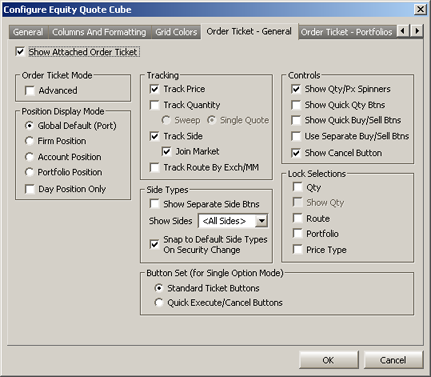
An Order Ticket can be attached to the Equity Quote Cube.
From the
Order Ticket tab in the configuration
window, check Show Attached Order
Ticket.
Alternate Methods:
From
the Equity Quote Cube window, right-click and select Show Order
Ticket.
From
the Config menu select Show Order Ticket.
Select
the Show/Hide Order Ticket button  .
.
Additional order options such as start/stop times, % volatility, IOC routes, and Stop Limit and Stop Market orders are available in the ticket's advanced mode.
Detailed
advanced mode information is available here.
Position Display Mode
The position field in the Equity Quote Cube order ticket can be configured to display one of five positions:
Global
Default (Acct)
Firm
Position
Account
Position
Portfolio
Position
Day Position Only
The Account Position reports position adjustments, while Portfolio and Day Position Only do not.
If the position is unknown or unobtainable, "unknown" will be displayed in the position fields.
The Global Default (Port) position references the Default Position Mode that was selected in Global Configuration.
Tracking
The Order Ticket can be configured to track (i.e., match) a value in the Equity Quote Cube and automatically place that value in the Order Ticket.
Tracking Options:
Track Price—The ticket will use the price of the currently selected quote.
Track Quantity—When a security is clicked in the Equity Quote Cube, the order quantity will be placed in the QTY field of the Order Ticket. Select one of two options for quantity tracking:
Sweep—The ticket will use the sum of the
quantities for all quotes above and including the selected quote.
This is useful when taking the market to "sweep" up
the top of the book.
Single Quote—The ticket will use the quantity of the selected quote.
Track Side—If selected, when a quote is clicked in the ASK grid, the Order ticket will track its side to BUY. When clicked in the BID grid, it will track its side to SSH.
Join Market—Causes the ticket to select the BUY side for a Bid and the SELL side for an Ask.
Track Route by Exch/MM—If checked, the Order Ticket will select a route based on the Exchange or Market Maker of the selected quote and the Equity Quote Source mapping in Global Configuration.
All other instructions for configuring the Order Ticket can be found here.
Note: Order Tickets launched from the Equity Quote Cube (via the send to-->Order Ticket command) also obey the tracking configuration.
Side Types

Show Separate Side Btns—Check this box to display all the selected side types from the drop-down list (BYO, BYA, SLO, SLA, etc.) on the Order Ticket. If unchecked, only the Buy and SEL buttons (or SSH depending on your configuration) will display.
Show Sides—To display any or all of the available Side Types, choose the Side Type(s) to display from the drop-down list. Select <All Sides> box to show all Side Types on the Order Ticket.
The Order Ticket in Equity Quote Cube supports the following Side Types:
BUY
BYC (Buy to close)
BYA (Auto buy)
SEL (Sell long)
SLA (Auto sell)
SSH (Sell short)
SSE (Sell Short Exempt)
Notes on Side Types
BYC—Generally used for options, but can be used for stocks on a per-route basis. Not allowed for futures.
BYA—The order will be a BUY if it results in a positive position. The order will be a BYC if it results in a zero or negative position.
Note: BYA is enabled for equities only and can only be used if the selected route supports equity BYC.
SLA—Equities only, not allowed for futures The auto sell side type automatically chooses between SEL and SSH based on the current position.
SSH—Equities only, not allowed for futures.
SSE—A short sale in which the uptick rule doesn't apply to the trade, i.e., the trade can go through on a down tick as opposed to a standard short sale in which the order has to be done on an uptick.
Snap Side Types to Defaults On Security Change
When you change a Symbol in the Order Ticket, default sides types will be displayed in the Order Ticket if you check this box. Buy Side Types are BUY and BYC. Sell Side Types are SEL, SLA, SSH, SSE.
Controls
Show Qty/Px Spinners—Spinners are the up/down arrows adjacent
to the Qty and Px
fields and are used to adjust the
quantity and price without the need to manually key in a value:

Price field with Spinners enabled
Show Quick Qty Btns—When selected, buttons reflecting values to be added to the Qty field are displayed in the Order Ticket. The values are:
+100
+500
+1K
+2.5K
+5K
+10K
Each button can be combined with other buttons for a desired total (i.e., +100 button + +500 button = Qty of 600).
Select
the Clear Qty button
to set the Qty value
to zero.

Quick Qty Btns
Show Quick Buy/Sell Btns—Check this box to display six quick buy/sell buttons in these amounts:
SEL 1K
SEL 500
SEL 100
BUY 100
BUY 500
BUY 1K
The selected side types are reflected in the quick buy/sell buttons (for example, if the side type is SSH, the quick sell buttons will be SSH 1K, SSH 500, and SSH 100)

Quick Buy/Sell Btns
Use Separate Buy/Sell Btns
When checked, the default ticket layout of one Buy button, one Sell button, and a third button that reflects buy/sell and price will be replaced by two buttons each reflecting the price. If applicable (based on routes and permissions), each button allows for the selection of a different side type.

Separate buy/sell buttons showing quantity and price. Side types can be selected from each button.
Show Cancel Button—The Cancel button allows you to cancel all live orders for the security selected in the Equity Quote Cube. Check the Show Cancel Button to display it.

Cancel all live orders for a security with the Cancel button.
Lock Selections
Lock override default settings in the Global Configuration.
Global settings such as routes, portfolios, price types, etc. can be associated with certain symbols or security types. When a symbol is entered, the global settings are called in automatically. If the defaults are to be overridden (for example QTY is changed to 500 from the default of 100), and Lock Selection is enabled, each symbol that's entered in the Order Ticket will have a QTY value of 500.
As
an alternative to the configuration window, the lock button  on the Order Ticket can
be employed to lock selected fields.
on the Order Ticket can
be employed to lock selected fields.
Order Ticket - Portfolios

The Portfolio Firms and their respective portfolios that are available for selection in the Port field of the Equity Quote Cube Order Ticket are listed here.
In the top portion of this window check the Portfolio Firms that are to have their portfolios listed. Check <All Firms> to select all Portfolio Firms.
The portfolios for each Portfolio Firm will be displayed in the bottom portion of the window. Check the portfolios that will be available for selection or <All Portfolios> to select them all.
Alternate Method for Selecting Portfolio Firms
In the drop-down menu in the Port field, you can also select the Portfolio Firms:
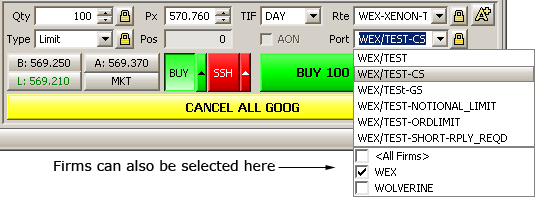

The ticker displays historical and real-time prints for a chosen security. Displaying the ticker is optional. The columns displayed in the ticker along with the styles (font/color) can be customized.
Show/Hide Ticker
Select the
Show/Hide Ticker
button  to view the ticker.
to view the ticker.
Alternate Methods:
Right-click on the Equity Quote Cube
and choose Show Ticker.
From the Config menu,
select Show Ticker.
From the configuration screen under "Ticker" check the Show Ticker box.
The "Show Ticker" is a toggle command. Any of the methods above can be selected to hide the ticker.
Limit to _ _ _ ticks
The value in the Limit to _ _ _ ticks field refers to the number of visible ticks in the ticker.
Allow Historical Ticks
When checked, Allow Historical Ticks gets previous ticks from the day. If unchecked, the ticker will show only those ticks from the time the ticker was enabled.
© 2015 Wolverine Execution Services, LLC